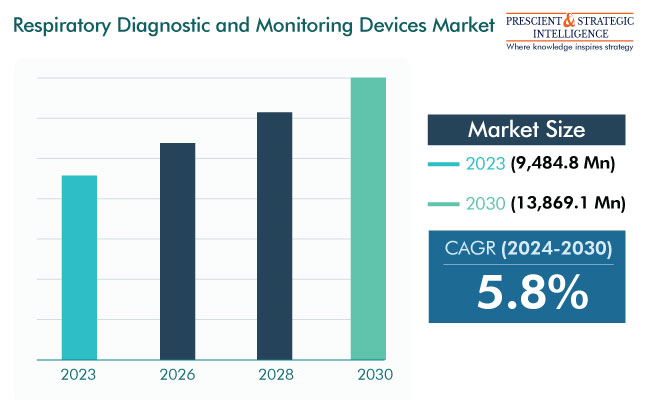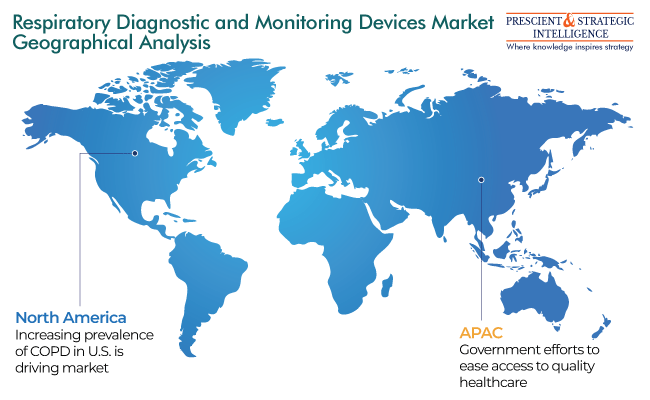Report Code: 10740 | Available Format: PDF
Respiratory Diagnostic and Monitoring Devices Market: Historical Size and Share Analysis, Future Growth Potential, Key Regions, Forecast till 2030
- Report Code: 10740
- Available Format: PDF
- Report Description
- Table of Contents
- Request Free Sample
Market Overview
The respiratory diagnostic and monitoring device market will grow from USD 9,484.8 million (E) in 2023 to USD 13,869.1 million in 2030, at a CAGR of 5.8% between 2024 and 2030.
These devices include spirometers, pulse oximeters, gas analyzers, and capnography devices, which are used in managing diseases that affect the respiratory system. Diseases such as asthma, chronic obstructive pulmonary disease, emphysema, pulmonary edema, cystic fibrosis, and lung cancer, are usually diagnosed with physical examination and medical tests.

The growth of this industry is because of the increasing geriatric populace all over the world, as well as the growing prevalence of premature births. Additionally, the changing lifestyles, increasing consumption of tobacco, and rising healthcare expenses are helping the industry progress.
Additionally, the COVID-19 pandemic has brought about a rapid rise in the demand for medical devices. As per an article in The Hindu, in 2021, pulse oximeter prices in India had more than doubled, boosted by the burgeoning demand among individuals and their scarcity. As cases rose, people became aware of this vital tool in ascertaining their SpO2 levels, a key marker of respiratory function.
Hence, research institutions and manufacturers heavily invested in the development of new products during the pandemic, to meet the increasing requirement. Moreover, several medical device manufacturers introduced remote patient care systems to help governments and hospitals in fighting the pandemic. For example, in March 2021, Turtle Shell Technologies Private Limited, known as Dozee, launched Dozee Pro, which features an AI-powered triaging system that allows for remote patient monitoring outside the ICU.
Rising Prevalence of Premature Births Boosts Market
Premature births are the main cause of infant death across the globe. Premature babies have a high risk of death and catching serious diseases during the neonatal stage itself because of poor body temperature regulation, difficulty in feeding, and weak respiration.
As per the WHO, in 2020, approximately 13.4 million babies were born prematurely. Moreover, premature birth complications accounted for almost 900,000 deaths in 2019. Furthermore, surviving infants may be required to spend months in a neonatal intensive care unit and might face intellectual disabilities, breathing problems, impaired vision, cerebral palsy, and hearing loss. Therefore, to monitor premature infants, the requirement for respiratory care devices will increase significantly in the years to come.
Changing Lifestyles and High Tobacco Consumption Increase Respiratory Disorder Occurrence
Tobacco consumption is one of the major causes of death globally because it is responsible for causing long-term illnesses, such as cancer. As per the WHO, smoking causes around 10% of the cardiovascular disease cases, 42% of chronic respiratory ailment cases, and approximately 71% of the lung cancer cases. Most of the people who smoke are from middle-and low-income nations, thus resulting in a high burden of tobacco-related deaths and diseases here.
Every year, over 8 million people die because of tobacco. Among these, 7 million deaths are due to direct tobacco use, while approximately 1.3 million are of non-smokers exposed to second-hand smoke. To detect diseases related to tobacco consumption, the requirement for respiratory diagnostic and monitoring devices will continuously increase all over the world.
| Report Attribute | Details |
Market Size in 2023 |
USD 9,484.8 Million (E) |
Revenue Forecast in 2030 |
USD 13,869.1 Million |
Growth Rate |
5.8% CAGR |
Historical Years |
2017-2023 |
Forecast Years |
2024-2030 |
Report Scope |
Market Trends, Drivers, and Restraints; Revenue Estimation and Forecast; Segmentation Analysis; Impact of COVID-19; Companies’ Strategic Developments; Market Share Analysis of Key Players; Company Profiling |
Explore more about this report - Request free sample
Pulse Oximeters Are Leading Product Type Category
The pulse oximeter category, based on product type, is leading the industry. This is a noninvasive technique to monitor the oxygen level of an individual and extremely useful for detecting, monitoring, and prognosing lung conditions, such as COPD. The increasing R&D activities for improving the effectiveness of these devices and integrating them with internet connectivity are boosting the market.
Hospitals Are Largest Contributor
The hospitals category is the largest contributor to the respiratory diagnostic and monitoring device industry. This is primarily because of the higher footfall of patients at these places than long-term care centers, diagnostic centers, and nursing homes. Moreover, the pandemic outbreak has significantly pushed the progress of this category. Many COVID-19-infected patients experience mild-to-moderate respiratory symptoms, which makes these devices extremely important.
The homecare category is likely to advance at a significant rate during the projection period. This can be attributed to the increasing healthcare expenditure, most of which goes into routine checkups. Furthermore, the emphasis on caring for patients at the bedside is driving the development of home-use diagnostic and monitoring technologies. In addition, the pandemic has brought about an increase in the count of patients consulting medical professionals from home through telemedicine.
Key Companies in Respiratory Diagnostic and Monitoring Device Market
- General Electric Company
- Masimo Corporation
- Koninklijke Philips N.V.
- Medtronic plc
- Drägerwerk AG & Co. KGaA
- Getinge AB
- Medical Depot Inc.
- Fisher & Paykel Healthcare Ltd
- ResMed Inc.
- DeVilbiss Healthcare LLC
- Teleflex Incorporated
- Shenzhen Mindray Bio-Medical Electronics Co. Ltd.
North America Is Market Leader
North America is the major contributor to the industry, primarily owing to the increasing prevalence of breathing-related illnesses. As per the American Lung Association, 12.5 million people in the U.S. are affected by COPD, and thus, they need oximeters and capnography devices as a mandate.
Moreover, as per the data of the Centers for Disease Control and Prevention, each year, more than 480,000 deaths in the U.S. occur due to cigarette smoking. Additionally, over 41,000 deaths are because of second-hand smoke exposure. Therefore, the rising count of breathing assistance and surgical procedures across the region will help in the progress of the industry.
APAC will advance at the highest rate till the end of this decade, primarily because of the high prevalence of chronic ailments, increasing medical expenditure, and improving healthcare infrastructure. Furthermore, India and China are offering significant growth opportunities to the players due to the lack of quality care and large patient pools. More than 90% of the deaths due to COPD in people less than 70 years of age are recorded in LMICs, which most of the countries in APAC are.

In addition, the Japanese market is growing swiftly because of the existence of a large aging population. As per an article by BBC, almost 30% of Japan’s population is aged 65 years or above, making the country the most-aged in the world. The country also has one of the lowest ratios of children to the aged, which means the elderly have only a few to care for them. This boosts the demand for home-use respiratory diagnostic and monitoring devices in Japan.
Want a report tailored exactly to your business strategy?
Request CustomizationWant an insight-rich discussion with the report author?
Speak to AnalystOur dedication to providing the most-accurate market information has earned us verification by Dun & Bradstreet (D&B). We strive for quality checking of the highest level to enable data-driven decision making for you
Our insights into the minutest levels of the markets, including the latest trends and competitive landscape, give you all the answers you need to take your business to new heights
With 24/7 research support, we ensure that the wheels of your business never stop turning. Don’t let time stand in your way. Get all your queries answered with a simple phone call or email, as and when required
We take a cautious approach to protecting your personal and confidential information. Trust is the strongest bond that connects us and our clients, and trust we build by complying with all international and domestic data protection and privacy laws